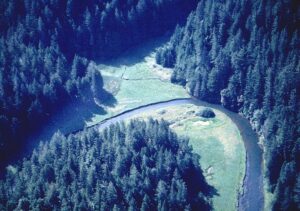The Albion Field Station of Pacific Union College has produced an amazing body of work after 60 years of research on myriad topics relating to the Mendocino Coast. Thirty years ago, Dr. Richard White was publishing “Mendocino Medicine and Gazetteer” and highlighted the station’s research on natural history. Here’s some information on the Albion area I’d bet most folks don’t know exists.

Railroad Slough on the Albion River (photo courtesy Rixanne Wehren)
From 1984 to 1993, White shared research fascicles (chapters) in his publications including: Ecological Studies of the Albion River, Natural History of Continental Islands, Hydroids, Sponges, Jellyfish, Anemones, Intertidal and Sub-tidal Zone Marine Life, and Gastropod and Bivalve Seashells.
The following is a gleaning of interesting tidbits from the fascicles. Like…In rainy season no upriver flows of tide water shows with no extra salinity, but in dry seasons incoming tides sweep up the channel giving the Albion River a seasonal estuary almost three miles inland. In the 1940’s, when research was done, the estuary was thirty- to fifty-feet wide and twenty- to twenty-five-feet deep. The south bank of the river had been dredged for a deeper channel when the sawmill existed. The old mill pond was then a mooring basin.
Water temperature in the estuary could range between 49° and 80° F. There is less marine life as the temperature increases. The 80-degree temperature was at Railroad Slough at low tide. Water temperature fluctuations of seven to eleven degrees occurred during tidal changes. Tides influenced the salinity of the river four to five miles inland.
Life forms in the river reacted to salinity. Acorn Barnacles could deal with variations and could exist three miles upriver, while crabs were only found within a half mile of the coast. Snails, Limpets, and Perch Stickleback fish reached no farther than Pleasant Valley, where the research station is located. Trees like Alder that border the river get water from moisture seeping downhill to the river and they grow their roots uphill to capture the fresh water. Eel Grass is halophytic and resistant to the deleterious effects of salt. Salt Grass is the predominate vegetation at Railroad Slough.
Researchers loved to study Railroad Slough. The mud there was especially sticky since decomposing organic matter from logging days mixed with clay, which precipitates out of groundwater when salinity increases.
The 1949 study of the slough, located about three miles upriver, explained it was formed from a break in an old, elevated logging railroad track bed resulting in a slough twenty-five feet wide and four feet deep and the about nineteen acres in size.
A tidal lag of two hours and forty minutes occurs at the slough, and at that time, it produced a repulsive smell of hydrogen sulfide and ammonia that was nauseating to human beings, but Speckled Sanddab Flounder six inches long, and Jack Smelt up to one foot long, did just fine in slough waters.
The Pleasant Valley mud flat had Redwood logs in the water with 1/4” to 3/8” holes made by Ship Worms (Bankia setacea). This scourge of wharf pilings is actually a clam that uses its vestigial shell as a boring tool. Shore Crabs and Rock Louse live in the holes.
Ghost Shrimp in the mooring basin can live 15 years. (Who watches a single shrimp’s life cycle for 15 years, and how?) Four-inch-long Lug Worms lived in the basin waters and Acorn Barnacles were the dominant animal living in the pilings.
There are nineteen species of sponges studied along the river and harbor in the 1950’s. They are often overlooked because they are inconspicuous and closely resemble each other. Some sponge species could be stiff and brittle, while others were leathery and exuded colorless slime when injured. Some could sting. Hermit Sponges were home to Hermit Crabs.
The fascicles on Bivalve Seashells showed a varied offering of sea life in shells. There were California, Bay and Northern Horse Mussels, Pea Pod Oysters, Pink, Giant Rock, and Nuttall’s Scallops, Asian, Surf and Rock Borer Clams, Littleneck Cockles, and Ship Worms.
The chapters “Sub-tidal Ecology of Marine Life near Albion in 1949” focused on the north side of Salmon Point, one mile south of the Albion Bridge. The study found a plateau eight to sixteen feet below the sea level surface before dropping off sharply. Maps drawn for the study reveal the composition of the bay’s floor, the currents, common animals, as well as twenty-three pages listing all the species.
The Jellyfish of Albion study looked at planktonic (passively floating) and pelagic (surface dwelling) transparent carnivorous creatures eating smaller zooplankton. Jellyfish were eaten by larger fish. There were sixteen species, the biggest being the Lion’s Mane at three feet in diameter and trailing thirty-five-foot-long tentacles. Another study highlighted fifteen distinct kinds of anemones found locally.
The Kelley House was lucky to have bound volumes of ”Mendocino Medicine and Gazetteer” by the late Dr. Richard White loaned to us by his wife Deborah before she moved to Henderson, Nevada. While we extracted these tidbits, the Museum does not own a complete collection of the publication. For more information on the research noted in this story contact the Albion Field Station which undoubtedly has a library of research reports generated by student and staff over the decades.
Visit the Kelley House Museum, open Th – Sun, 11 AM – 3PM. Walking tours ($20) of Mendocino are offered Saturday and Sunday at 11 AM, and Tuesdays at 2 PM. Located at 45007 Albion Street, Mendocino. www.kelleyhousemuseum.org